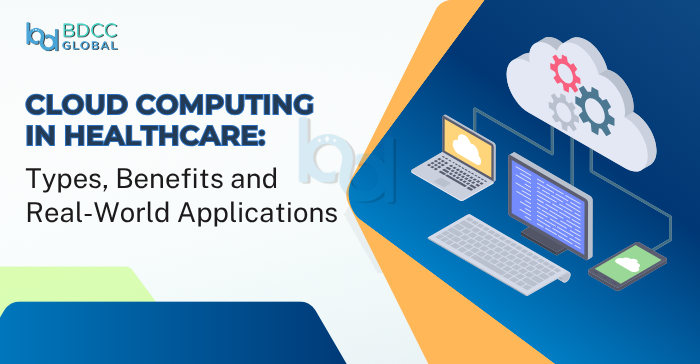
From digitized patient records to real-time virtual consultations, modern healthcare is undergoing a massive transformation and at the center of it all is cloud computing. What was once confined to tech companies and enterprise IT is now a game-changer for hospitals, clinics, research institutions and even small practices.
But what exactly does cloud computing in healthcare mean today? How is it changing the way care is delivered, managed and improved? And what do providers need to know before making the shift?
Let’s explore the types, benefits, applications and challenges of cloud-based healthcare systems. This way you can make informed decisions in a rapidly evolving landscape.
What is Cloud computing in healthcare?
Cloud computing in healthcare refers to the use of remote servers accessed over the internet to store, manage and process healthcare data, rather than relying solely on local servers or personal computers. These services can include data storage, EMR/EHR systems, analytics, telemedicine platforms and AI tools.
It enables healthcare providers to store massive volumes of patient data securely, access that data from anywhere and integrate with other systems more easily—all while reducing costs.
But how is this different from traditional IT infrastructure?
Traditional IT setups often require heavy hardware investments, ongoing maintenance and limited scalability. Cloud-based systems offer agility, scalability, cost-effectiveness and real-time collaboration, making them ideal for today’s fast-paced healthcare environment.
Types of Cloud computing in healthcare
Cloud services in healthcare can be categorized in two main ways: by deployment model and by service distribution. Understanding these types is essential to choosing the right solution for your healthcare organization.
Public cloud
Operated by third-party cloud providers (e.g., AWS, Google Cloud, Azure), offering services over the internet. Ideal for scalability but may require extra security layers.
Private cloud
Dedicated cloud infrastructure is operated solely for a single organization. Offers more control and better compliance but at higher costs.
Hybrid cloud
A mix of public and private clouds, allowing data and applications to be shared between them. This is ideal for balancing cost, control and compliance.
Infrastructure as a Service (IaaS)
Provides virtualized computing resources (servers, storage, networking). Good for healthcare startups or research organizations needing flexible IT infrastructure.
Platform as a Service (PaaS)
Offers hardware and software tools over the internet. Enables developers to build and deploy applications quickly useful for telemedicine apps or analytics tools.
Software as a Service (SaaS)
Provides ready-to-use applications via the cloud (e.g., EHR systems, scheduling apps, patient portals). SaaS is widely adopted in hospitals and clinics for its ease of use and quick implementation.
What are the benefits of Cloud computing in healthcare?
So, why are so many healthcare providers moving to the cloud? Here are some key benefits of cloud computing in healthcare:
- Scalability: Easily expand storage and computing resources as your organization grows.
- Cost-efficiency: Pay-as-you-go pricing removes the need for costly on-premises hardware.
- Data accessibility: Access patient records and diagnostics in real-time across departments and locations.
- Collaboration: Enable better coordination between care teams, labs and specialists.
- Security and compliance: Advanced encryption, multi-factor authentication and HIPAA-compliant cloud platforms enhance patient data protection.
- Disaster recovery: Cloud systems enable fast data recovery during system failures or cyberattacks.
- Innovation enablement: Supports AI, machine learning and big data analytics for predictive healthcare.
In fact, when cloud computing is combined with AI, it enables powerful capabilities such as automated diagnostics, predictive care, and intelligent resource management. If you’re curious about how AI is shaping cloud computing as a whole, check out this insightful article on the impact of AI in cloud computing for a deeper dive.
What’s more, industries like finance are also rapidly adopting cloud to streamline operations, enhance security, and drive innovation—paralleling many healthcare use cases. For a broader perspective, explore the role of cloud in financial services and how similar benefits are transforming other regulated sectors.
Applications of Cloud computing in healthcare industry
Let’s look at some real-world applications of cloud computing in healthcare:
- Electronic Medical Records (EMRs/EHRs)
Store and retrieve patient data securely, enabling seamless communication between physicians, nurses and specialists.
- Telemedicine and virtual care
Cloud platforms support video consultations, remote monitoring and mobile health applications—especially critical during and after the COVID-19 era.
- Medical imaging and diagnostics
Upload and share high-resolution images like MRIs and CT scans with radiologists instantly, improving diagnosis times.
- Healthcare analytics
Cloud-based analytics platforms can process vast datasets to predict patient risks, improve outcomes and reduce readmissions.
- Interoperability and data integration
Cloud platforms allow easier integration between labs, pharmacies and hospitals, ensuring better coordination of care.
- Genomics and research
Bioinformatics and genomics research rely on massive compute power and storage, which cloud platforms provide efficiently.
Challenges of Cloud computing in healthcare
While the benefits are strong, it’s important to consider the challenges of cloud computing in healthcare:
- Data security and privacy: Despite encryption and compliance tools, concerns remain about unauthorized access and data breaches.
- Compliance and regulations: Navigating laws like HIPAA, GDPR and local data residency requirements can be complex.
- Downtime risks: Outages, even rare, can interrupt critical care services. Redundancy and disaster recovery planning are essential.
- Vendor lock-in: Switching cloud providers can be difficult once systems are integrated. It’s important to choose partners carefully.
- Skill gaps: Healthcare organizations may lack in-house expertise to manage and secure cloud environments.
Final thoughts
Cloud computing is not just a trend; it’s the foundation of future-ready healthcare systems. It enables organizations to deliver better care, improve collaboration and unlock innovations that were previously out of reach. However, its success depends on thoughtful planning, strong cybersecurity practices and choosing the right cloud partners.
For healthcare providers aiming to assess or improve their current cloud capabilities, understanding where you stand on a maturity scale can be incredibly helpful. Here’s a useful guide on how a cloud maturity model can improve cloud capability that can help you evaluate your current approach and plan strategically.
As healthcare becomes more data-driven, agile, and patient-centric, cloud healthcare solutions will continue to evolve as a strategic necessity rather than an option.
FAQs
1. Is cloud computing secure for storing patient health records?
Yes, major cloud providers offer HIPAA-compliant and encrypted solutions designed for secure healthcare data management.
2. What is the difference between public and private cloud in healthcare?
Public clouds offer scalability and lower costs, while private clouds provide more control and compliance—ideal for sensitive data.
3. How does cloud computing improve patient care?
It enables real-time data access, remote monitoring, telehealth and better coordination between care teams.
4. Can small clinics benefit from cloud computing?
Absolutely. Many SaaS solutions are budget-friendly and scalable for smaller practices, improving efficiency without major infrastructure investment.
5. What are examples of cloud-based healthcare apps?
EHR platforms (like Epic or Cerner on the cloud), telemedicine services (like Teladoc) and remote patient monitoring tools are common examples.
BDCC
Latest posts by BDCC (see all)
- Cloud computing in healthcare: Uses and benefits - June 23, 2025
- What are the Best Practices for Terraform File Structure? - June 10, 2025
- From Monolith to Microservices: DevOps Strategies For a Smooth Transition - June 5, 2025

